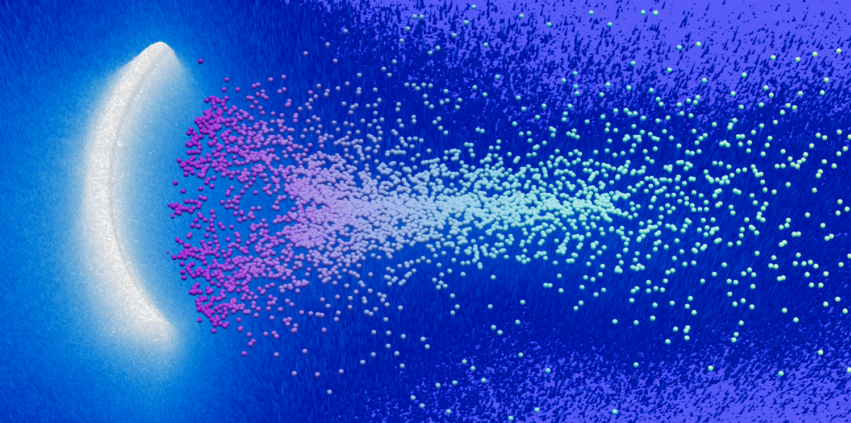Berkeley Lab Leads SciDAC Project
3 min read

ATAP researchers aim to develop next-generation algorithms to advance our understanding of laser-driven inertial fusion energy.
ATAP researchers aim to develop next-generation algorithms to advance our understanding of laser-driven inertial fusion energy.
Fusion promises an almost unlimited supply of carbon-free energy by replicating the processes that power our Sun. It could be a significant step in helping to address climate change, meet global energy needs, and reduce energy costs. Fusion is a priority area for the U.S. government, as evinced in the Bold Decadal Vision for Commercial Fusion Energy summit held at the White House last March.
The fusion process, however, can only happen when atoms are subjected to intense heat and pressure to overcome the tremendous physical forces and relatively low probability of occurrence and fuse.
Researchers from the Accelerator Technology & Applied Physics (ATAP) and the Applied Mathematics & Computational Research (AMCR) divisions at Berkeley Lab have teamed up with colleagues from Lawrence Livermore National Laboratory, the University of Rochester, and Kitware, Inc., an IT company headquartered in New York, to develop further and apply simulation tools that could help accelerate a path towards the design of a reliable inertial fusion energy (IFE) pilot power plant.
The four-year project, “Kinetic IFE Simulations at Multiscale with Exascale Technologies,” is supported by funding from the U.S. Department of Energy’s Scientific Discovery Through Advanced Computing (SciDAC) program. It aims to create novel algorithms to advance our understanding of the impacts of kinetic effects, which can modify target implosions on critical stages of laser-driven IFE.
“This approach to achieving fusion uses powerful lasers to compress a capsule of deuterium-tritium (two isotopes of hydrogen) fuel to produce bursts of energy,” explains Jean-Luc Vay, a senior scientist and head of ATAP’s Accelerator Modeling Program (AMP), who is leading the project. The technique, he adds, led to a major milestone in the quest for fusion energy, with the first controlled fusion experiment reaching “energy breakeven” in the National Ignition Facility at Lawrence Livermore National Laboratory last December.
Berkeley Lab also has a long and deep history of contributing to IFE, drawing upon capabilities across the Lab ranging from plasma and beam science and advanced materials and photon sources to nuclear science and leadership in advanced modeling and exascale computing.
The project “builds on the great work that ATAP and AMCR researchers did together as part of the Exascale Computing Project that led to the 2022 Gordon Bell Prize,” says Ann Almgren, a senior scientist and head of the Applied Mathematics Department in AMCR. “We will develop new scalable, kinetic solvers emphasizing long-term stability for laser-plasma interactions in inertial fusion science. This is a great example of Lab’s commitment to team science.”
While fusion research has gone “hand-in-hand with increased computing power and advanced modeling techniques over the past few decades,” says Vay, “simulating the kinetic effects in the IFE process has been, until now, limited by the very high computational cost needed to cover a wide range of space and time scales.”
He adds that creating a viable path to an IFE pilot plant will “require significant improvements” in the numerical models used to simulate the interactions of the lasers with the capsule, “including, but not limited to, those focused on modeling kinetic effects from first principles.”
Vay says these improved models must capture the physics of kinetic effects in the plasma and instabilities in the laser-plasma interaction regions over the greatly expanded spatial and temporal scales encountered in IFE. However, recent advances in Particle-In-Cell (PIC) codes and methods and exascale computing, he notes, can help simulate the complex microphysics at the greatly expanded spatial and temporal scales encountered in IFE processes.
To build such models, the team will leverage the capabilities of the exascale PIC code WarpX—an award-winning code developed by a team of researchers led by AMP that can solve plasma physics problems from first principles at much larger and faster scales than before—augmented with additional recent and novel cutting-edge numerical methods.
This, says Vay, will enable simulations that can accurately account for the kinetic effects on critical stages of the IFE, such as the driver-target coupling, capsule compression, and burn stages.
“Our work aims to provide the next generation of PIC tools and methods able to simulate kinetic effects in IFE using much larger grids and over much longer timescales to create a more accurate and predictive model of the laser’s interaction with the IFE capsule, including the deuterium-tritium target.”
“Fusion could provide a way to decarbonize our economy and meet future energy needs,” said ATAP Division Director Cameron Geddes. “Realizing that promise is complex and technically challenging. This important research, which benefits from our leadership in exascale computing, will help to deepen our understanding of the fundamental processes of inertial fusion and supports national and international efforts to harness the power of fusion.”
